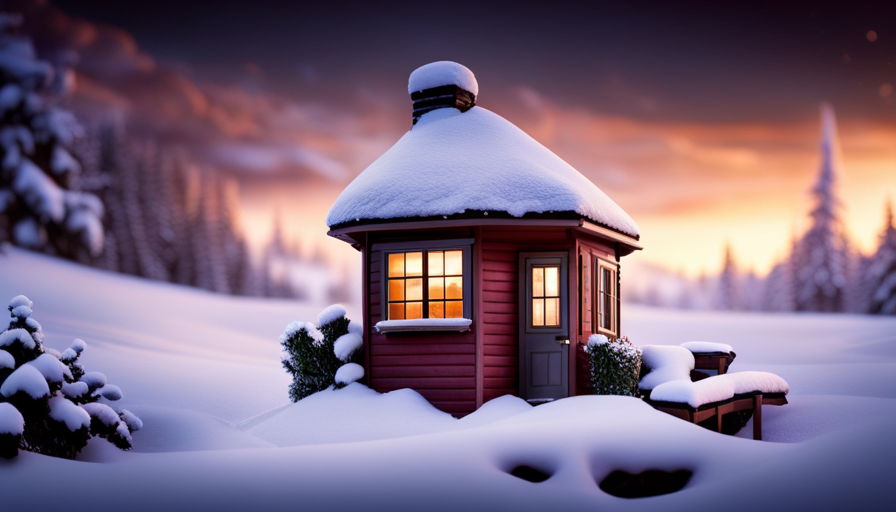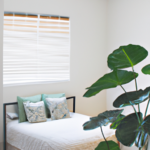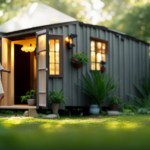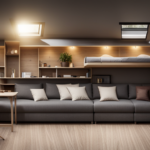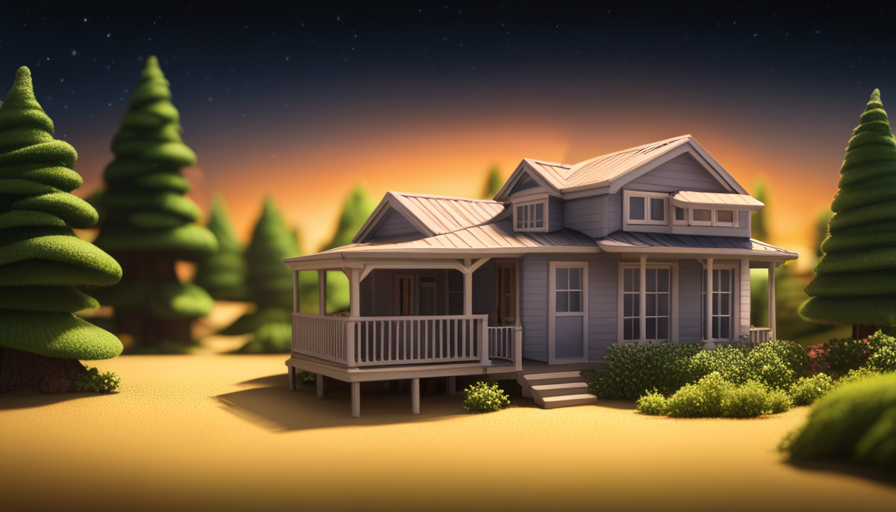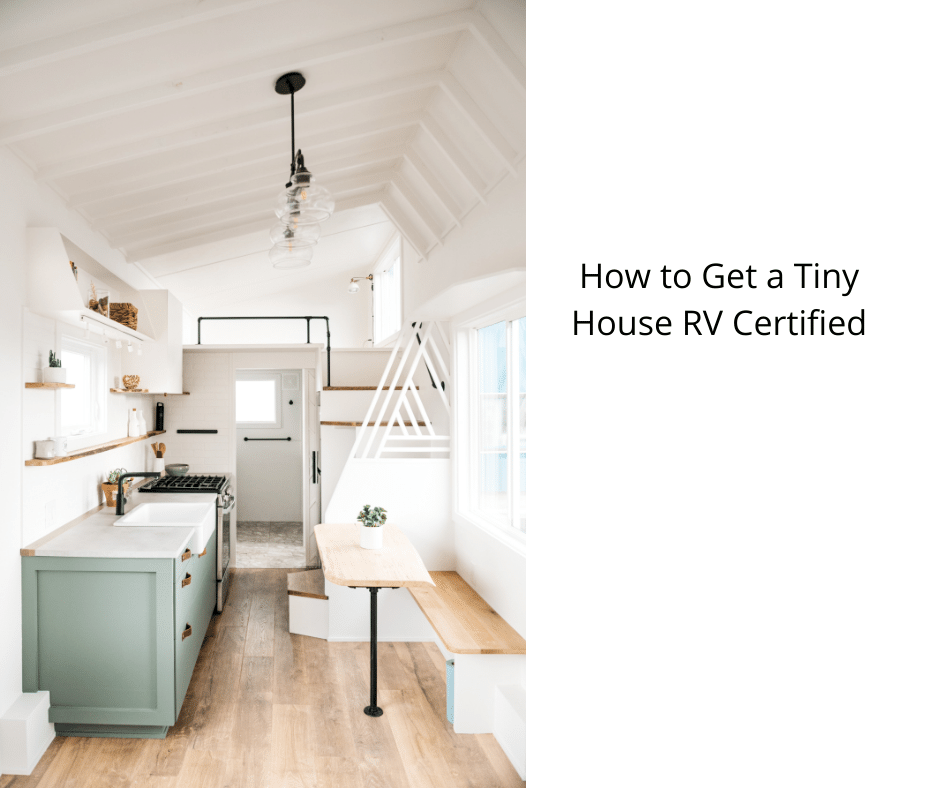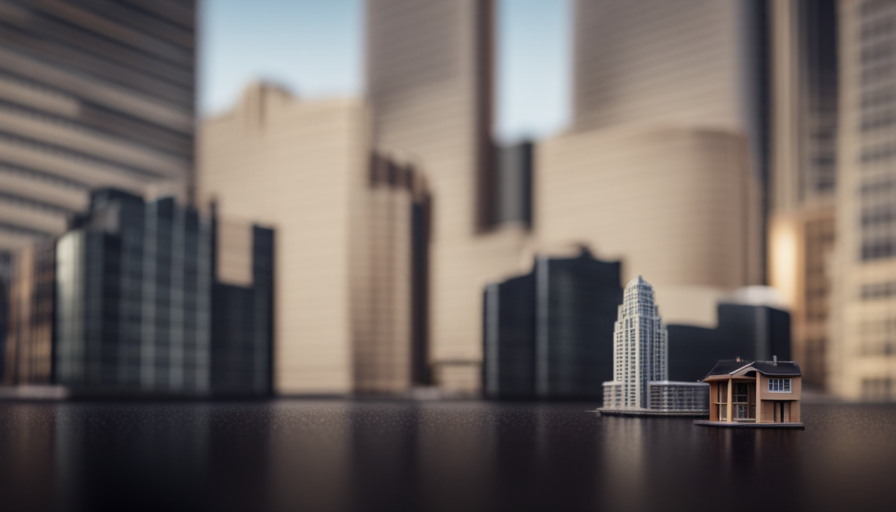Building a tiny house requires careful planning and consideration. It’s an exciting adventure that allows individuals to downsize, embrace sustainable living, and embrace a minimalist lifestyle. But what exactly is needed to make this dream come true?
In this article, I will guide you through the essential steps and elements involved in building a tiny house.
First and foremost, it is crucial to determine your budget and explore financing options.
Next, choosing the perfect location is vital for creating a harmonious living environment.
Designing the layout of your tiny house is where creativity comes into play, maximizing every inch of space efficiently.
Selecting the right materials and construction methods ensures durability and longevity.
Energy efficiency and sustainability should be at the forefront of your design, considering eco-friendly options for heating, cooling, and power sources.
Maximizing storage and organization is essential when working with limited space.
Adding personalized touches and decor will make your tiny house feel like home.
Lastly, it is crucial to follow local building codes and regulations to ensure a safe and legal construction process.
With careful planning and attention to detail, building a tiny house can be a rewarding and fulfilling experience. So, let’s dive into the exciting world of tiny house construction and discover what all you need!
Key Takeaways
- Careful planning and consideration are essential when building a tiny house.
- Financing options should be explored, including researching lenders and considering crowdfunding platforms.
- Choosing the perfect location for the tiny house is vital, considering factors such as accessibility, zoning regulations, utilities, surroundings, and future plans.
- Design considerations should prioritize space efficiency, sustainability, energy efficiency, and storage solutions.
Determine Your Budget and Financing Options
Before you start dreaming of your perfect tiny house, it’s important to figure out your budget and how you’ll finance your project. Determining loan options is a crucial step in this process. Research different lenders and compare interest rates, terms, and requirements.
Consider getting pre-approved for a loan to have a clear understanding of how much you can borrow. Another financing option worth exploring is crowdfunding. Platforms like Kickstarter and GoFundMe allow you to share your project with others who may be interested in supporting your tiny house journey. Craft a compelling campaign, showcasing your vision and the benefits of tiny living.
Transitioning into the subsequent section about choosing the right location, securing your finances is essential before moving forward with your tiny house plans.
Choose the Right Location
When selecting the perfect spot for your little abode, make sure to consider the right location. Finding the perfect spot for your tiny house is crucial as it’ll determine your overall living experience.
Here are some factors to consider when choosing the location for your tiny house:
- Accessibility: Ensure that the location is easily accessible and has good road connectivity.
- Zoning and Legal requirements: Check the local zoning regulations and legal requirements for building a tiny house in that area.
- Utilities: Make sure there are proper utilities such as water, electricity, and sewage connections available.
- Surroundings: Consider the surroundings and choose a location that aligns with your preferences, whether it’s a scenic view, proximity to nature, or a vibrant neighborhood.
- Future plans: Think about your future plans and whether the location will still be suitable in the long run.
Considering these factors will help you find the perfect spot for your tiny house.
In the next section, we’ll discuss how to design your tiny house layout.
Design Your Tiny House Layout
Crafting the layout of your compact sanctuary is where you can truly transform your tiny haven into a personalized oasis. When designing your tiny house interior, space optimization is key. By carefully planning the layout, you can maximize every square inch and create a functional living space that meets your needs. To help you visualize the possibilities, consider the following three column and five row table:
| Living Area | Sleeping Area | Kitchen | Bathroom | Storage |
|---|---|---|---|---|
In the living area, you can incorporate multifunctional furniture, such as a sofa that converts into a bed or a coffee table with storage compartments. The sleeping area can be elevated to create additional storage space underneath. The kitchen should be compact yet efficient, with space-saving appliances and clever storage solutions. A well-designed bathroom can include a shower, toilet, and sink in a compact layout. Lastly, ample storage throughout the tiny house is essential to keep everything organized and tidy.
In the next section, we will discuss how to select the right materials and construction methods to bring your tiny house vision to life.
Select the Right Materials and Construction Methods
To ensure the success of your tiny house project, it’s crucial that you select the right materials and construction methods, which can significantly impact the overall cost and sustainability of your compact sanctuary.
Did you know that using sustainable materials in your tiny house can reduce your carbon footprint by up to 35% compared to traditional construction methods?
When selecting materials, consider using renewable resources such as bamboo or reclaimed wood, as well as low VOC paints and finishes to promote indoor air quality.
Additionally, opt for energy-efficient insulation materials like spray foam or cellulose to minimize heat loss and reduce energy consumption.
Choosing the right construction methods, such as advanced framing techniques or modular construction, can also enhance the efficiency and durability of your tiny house.
By carefully selecting materials and construction methods, you can lay a solid foundation for an energy-efficient and sustainable tiny house project.
Consider Energy Efficiency and Sustainability
Consider using sustainable materials and construction methods to create an energy-efficient and eco-friendly sanctuary for yourself. By incorporating energy efficient appliances and sustainable building materials, you can significantly reduce your environmental impact and save on utility costs. Here are four key considerations to keep in mind:
- Energy efficient appliances: Opt for appliances that are ENERGY STAR certified, as they consume less energy and are more environmentally friendly.
- Sustainable building materials: Choose materials like reclaimed wood, bamboo, or recycled metal, which have a lower carbon footprint and promote resource conservation.
- Insulation: Use insulation materials with high R-values to minimize heat loss or gain, ensuring your tiny house remains comfortable year-round.
- Solar panels: Consider installing solar panels to harness renewable energy and reduce your reliance on the grid.
With these energy-efficient and sustainable choices, you can create a tiny house that not only benefits the environment but also provides a comfortable and cost-effective living space.
When planning for plumbing and electrical systems, it’s important to consider their integration into the overall design.
Plan for Plumbing and Electrical Systems
When it comes to planning for plumbing and electrical systems in your energy-efficient and sustainable sanctuary, don’t overlook the importance of seamless integration and efficient design. A well-designed plumbing layout and electrical wiring are crucial for the functionality and convenience of your tiny house. To ensure optimal performance, consider the following factors:
| Plumbing Layout | Electrical Wiring |
|---|---|
| Efficient use of space | Proper grounding and bonding |
| Water supply and drainage | Circuit breaker and fuse placement |
| Eco-friendly fixtures | Adequate outlets and switches |
By carefully planning your plumbing layout, you can maximize space utilization and minimize the risk of leaks or clogs. Choose eco-friendly fixtures and consider water-saving options to reduce your environmental impact. Similarly, a well-thought-out electrical wiring system is essential for safety and convenience. Ensure proper grounding and bonding to protect against electrical hazards, and strategically place circuit breakers and fuses for easy access. Adequate outlets and switches should be installed to meet your electrical needs.
Transitioning to the next section about maximizing storage and organization, it is important to consider efficient design principles to make the most of your tiny house space.
Maximize Storage and Organization
Don’t underestimate the power of efficient design when it comes to maximizing storage and organization in your energy-efficient and sustainable sanctuary. In a tiny house, every square inch counts, so it’s crucial to make the most of the available space.
Maximizing space is all about utilizing every nook and cranny creatively. Incorporating built-in storage solutions such as hidden cabinets, pull-out drawers, and under-the-stairs compartments can significantly increase your storage capacity. Consider utilizing vertical space by installing shelves or hooks on the walls.
Additionally, multipurpose furniture like storage ottomans or beds with built-in drawers can serve dual purposes. Utilizing clear storage containers or labels can help keep things organized and easily accessible. When it comes to add personalized touches and decor, consider incorporating storage solutions that double as decorative pieces, such as floating shelves or hanging baskets.
Add Personalized Touches and Decor
Make sure to infuse your energy-efficient and sustainable sanctuary with personalized touches and decor that truly reflect your unique style and personality, because who wants a cookie-cutter, soulless space anyway? Adding personal touches to your tiny house not only makes it feel like home, but also adds character and charm. Here are some ideas to inspire you:
| Category | Idea | Description |
|---|---|---|
| Wall Decor | Gallery Wall | Display your favorite photos and artwork in a curated gallery wall for a personalized touch. |
| Statement Piece | Hang a large, eye-catching piece of art or a unique tapestry that reflects your personality. | |
| Lighting | Pendant Lights | Choose pendant lights with interesting designs or colors to add a touch of style to your space. |
| String Lights | String lights can create a cozy and whimsical ambiance, perfect for a tiny house. | |
| Furniture | Multi-functional | Opt for furniture that serves multiple purposes, such as a storage ottoman or a fold-out table. |
Adding personal touches and decor to your tiny house will make it feel like a true reflection of yourself. It’s important to remember that while you have the freedom to personalize your space, it’s also crucial to follow local building codes and regulations to ensure the safety and legality of your tiny house.
Follow Local Building Codes and Regulations
After adding personalized touches and decor to my tiny house, it’s important to ensure that I’m following local building codes and regulations. This step is crucial to avoid potential legal implications and ensure the safety of the structure. Obtaining the necessary permits and permissions is essential before proceeding with the construction.
Hiring professionals who’re familiar with the local building codes can help navigate through the process smoothly and efficiently. However, there may be potential challenges in adhering to all the regulations, especially if the area has specific requirements for tiny houses.
Building community relationships and seeking guidance from local authorities can be beneficial in understanding and meeting these requirements. By following local building codes and regulations, I can create a safe and legal tiny house that complies with the standards.
Transitioning into the subsequent section, I can now enjoy the benefits of living in my tiny house.
Enjoy the Benefits of Living in a Tiny House
Now that you’ve followed all the necessary regulations and obtained the required permits, it’s time to fully embrace the unique and fulfilling lifestyle that comes with living in a cozy and charming tiny home. Small space living offers numerous benefits, such as lower utility costs, reduced environmental footprint, and simplified maintenance. Embracing a minimalist lifestyle allows you to focus on what truly matters, freeing yourself from the burden of excess possessions. In a tiny house, every item has a purpose and a place, promoting organization and efficiency. To make the most of your small space, consider incorporating multi-functional furniture and creative storage solutions. A table can serve as a dining area during mealtimes and a workspace during the day. Utilize vertical space with wall-mounted shelves and hooks to maximize storage options. Living in a tiny house may require some adjustments, but the rewards of simplicity, freedom, and sustainability make it an incredibly fulfilling way of life.
Frequently Asked Questions
How do I find land to park my tiny house on?
To find land to park my tiny house on, I can start by researching local zoning laws and regulations. I need to ensure that the land is zoned for residential use and complies with legal restrictions for tiny houses.
What are some popular design styles for tiny houses?
When it comes to designing tiny houses, two popular styles are minimalist and bohemian. While minimalist designs focus on simplicity and clean lines, bohemian designs embrace a more eclectic and artistic approach, incorporating vibrant colors and unique patterns.
Are there any specific materials that are recommended for building a tiny house?
Sustainable materials such as reclaimed wood, recycled metal, and bamboo are recommended for building a tiny house. These options are cost-effective and environmentally friendly, ensuring durability and reducing the overall carbon footprint of the construction.
How can I make my tiny house more energy efficient?
To make my tiny house more energy efficient, I can reduce water usage by installing low-flow fixtures and collecting rainwater. I can also incorporate renewable energy sources such as solar panels or a wind turbine to power my home.
What are some creative storage solutions for a tiny house?
Space saving furniture and clever organization are essential for maximizing storage in a tiny house. From hidden compartments in furniture to wall-mounted storage solutions, these creative options help make the most of limited space.
Conclusion
In conclusion, building a tiny house is a thrilling endeavor that requires careful planning and attention to detail. By determining your budget and choosing the right location, you can create a cozy and functional space. Designing a layout that suits your needs, selecting the right materials, and considering energy efficiency are also important factors. Additionally, following building codes ensures a sustainable and safe construction. Just like a conductor leading an orchestra, each step harmonizes to create a symphony of efficiency and comfort. Enjoy the freedom and simplicity of living in your very own tiny house.
I’m Theodore, and I love tiny houses. In fact, I’m the author of Tiny House 43, a book about tiny houses that are also tree houses. I think they’re magical places where imaginations can run wild and adventures are just waiting to happen.
While tree houses are often associated with childhood, they can be the perfect adult retreat. They offer a cozy space to relax and unwind, surrounded by nature. And since they’re typically built on stilts or raised platforms, they offer stunning views that traditional homes simply can’t match.
If you’re looking for a unique and romantic getaway, a tree house tiny house might just be the perfect option.

